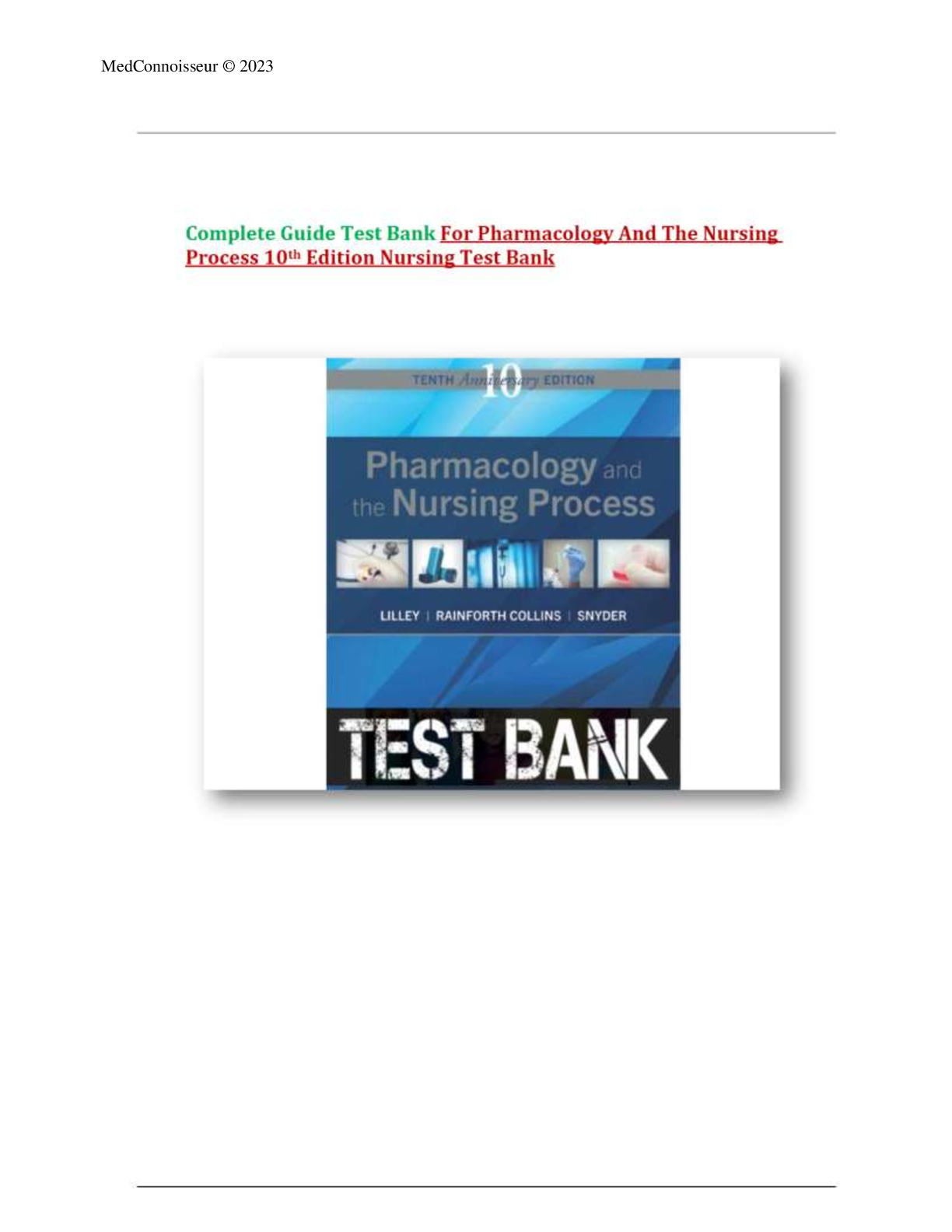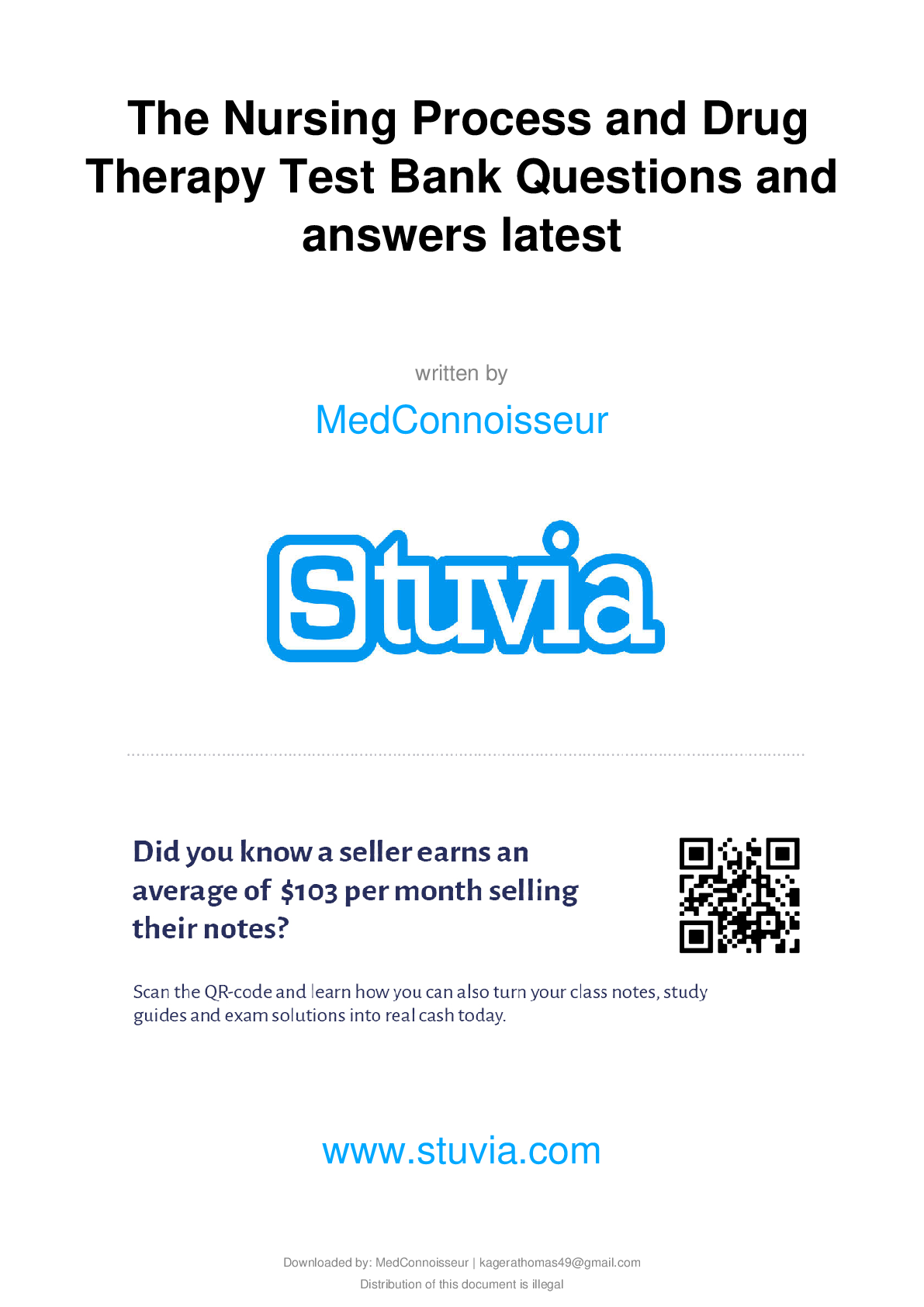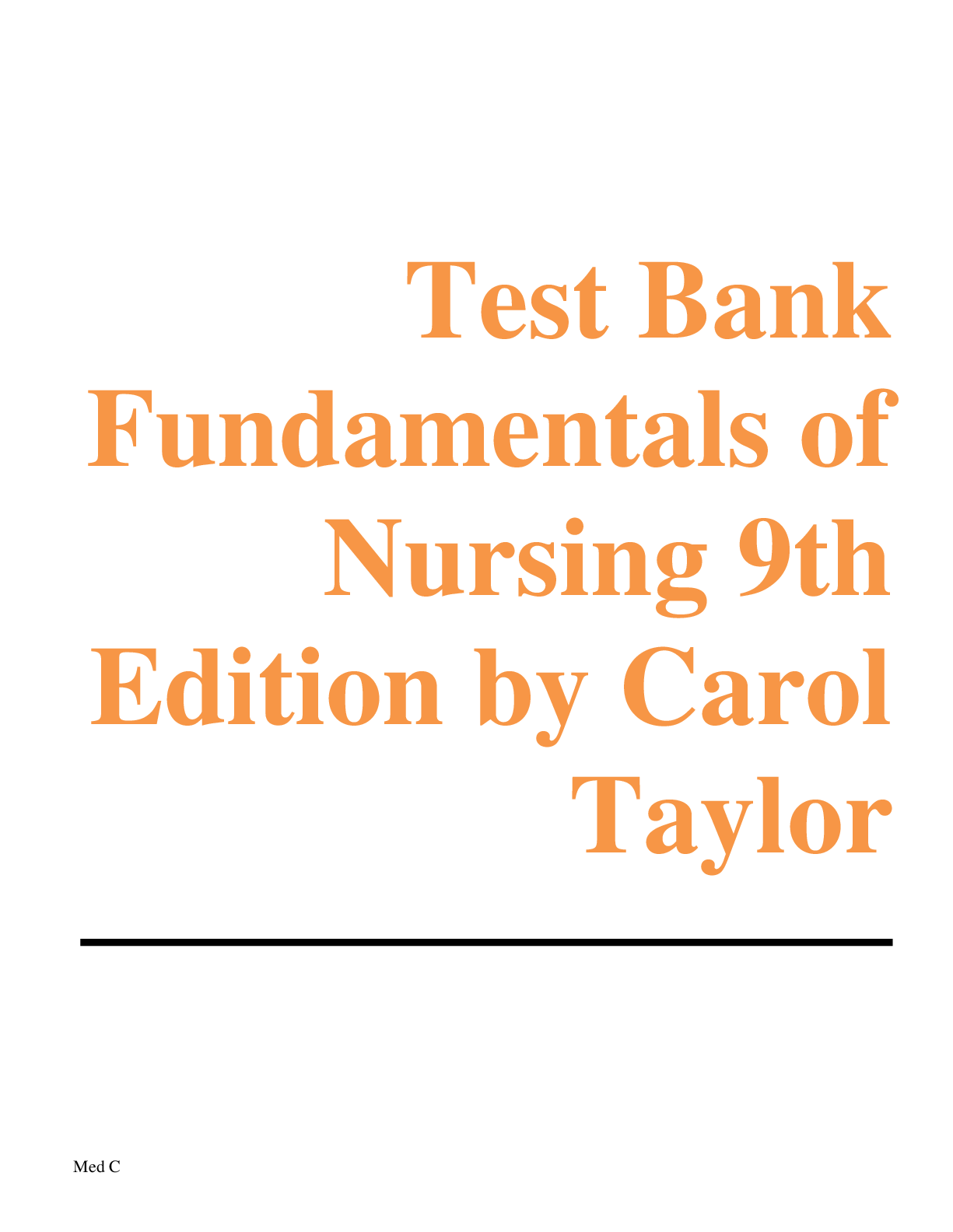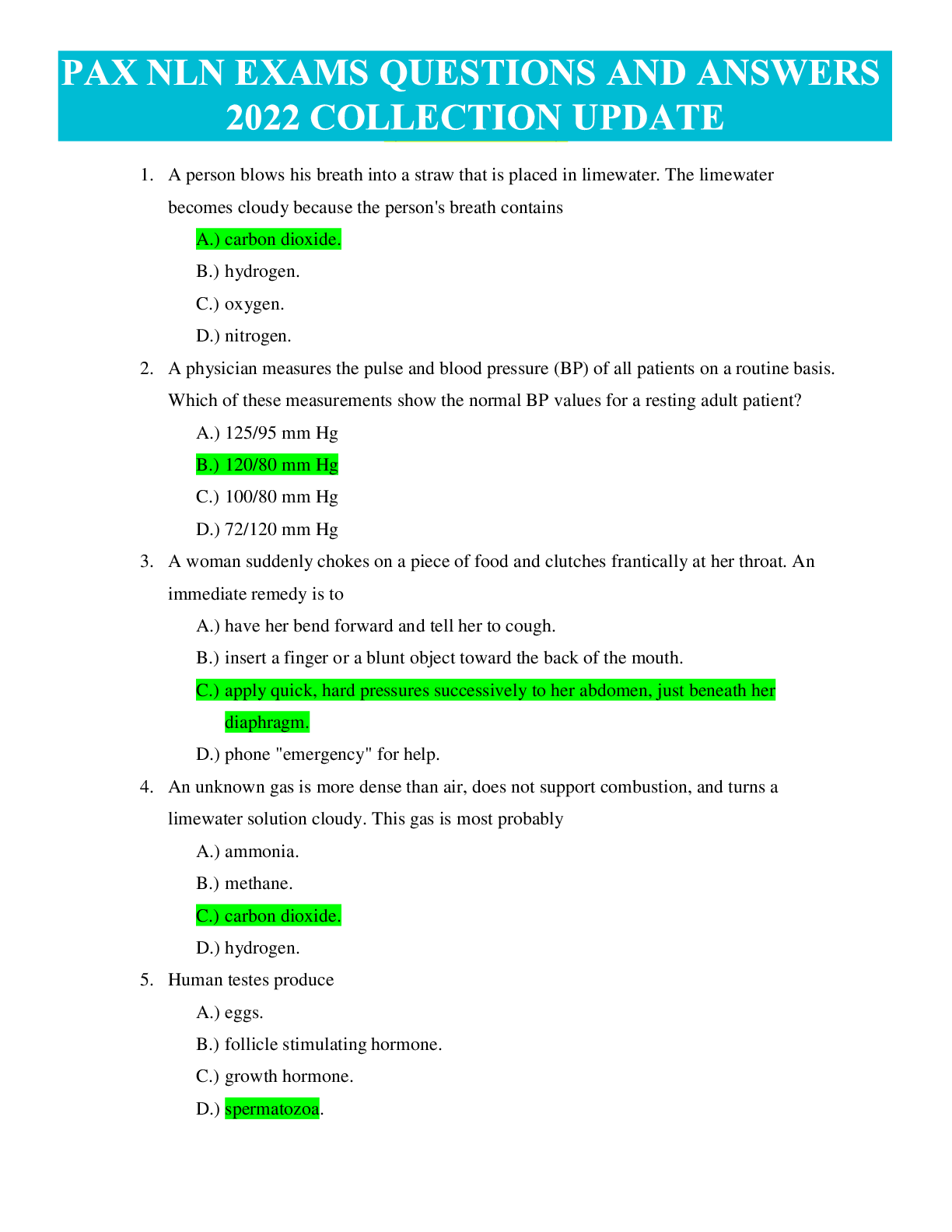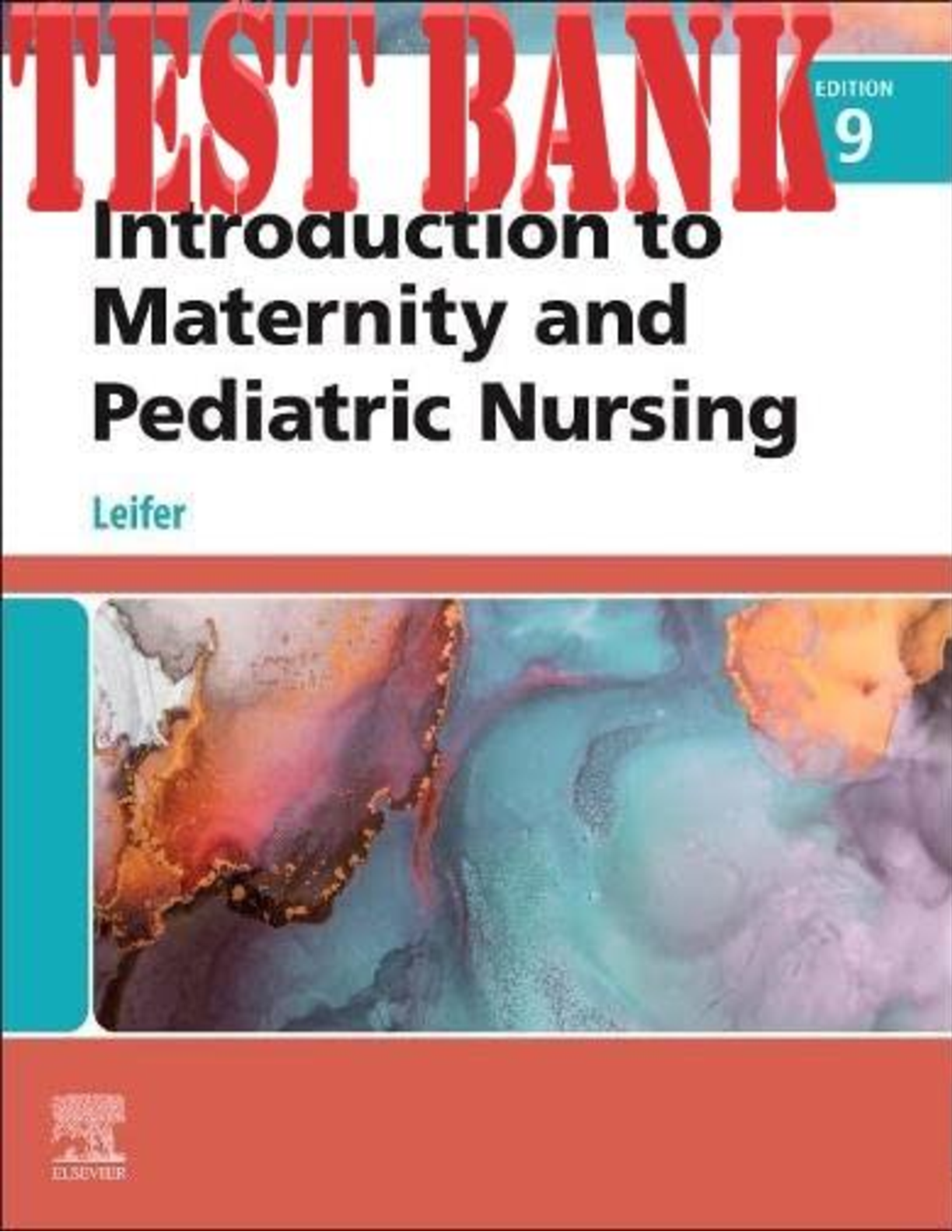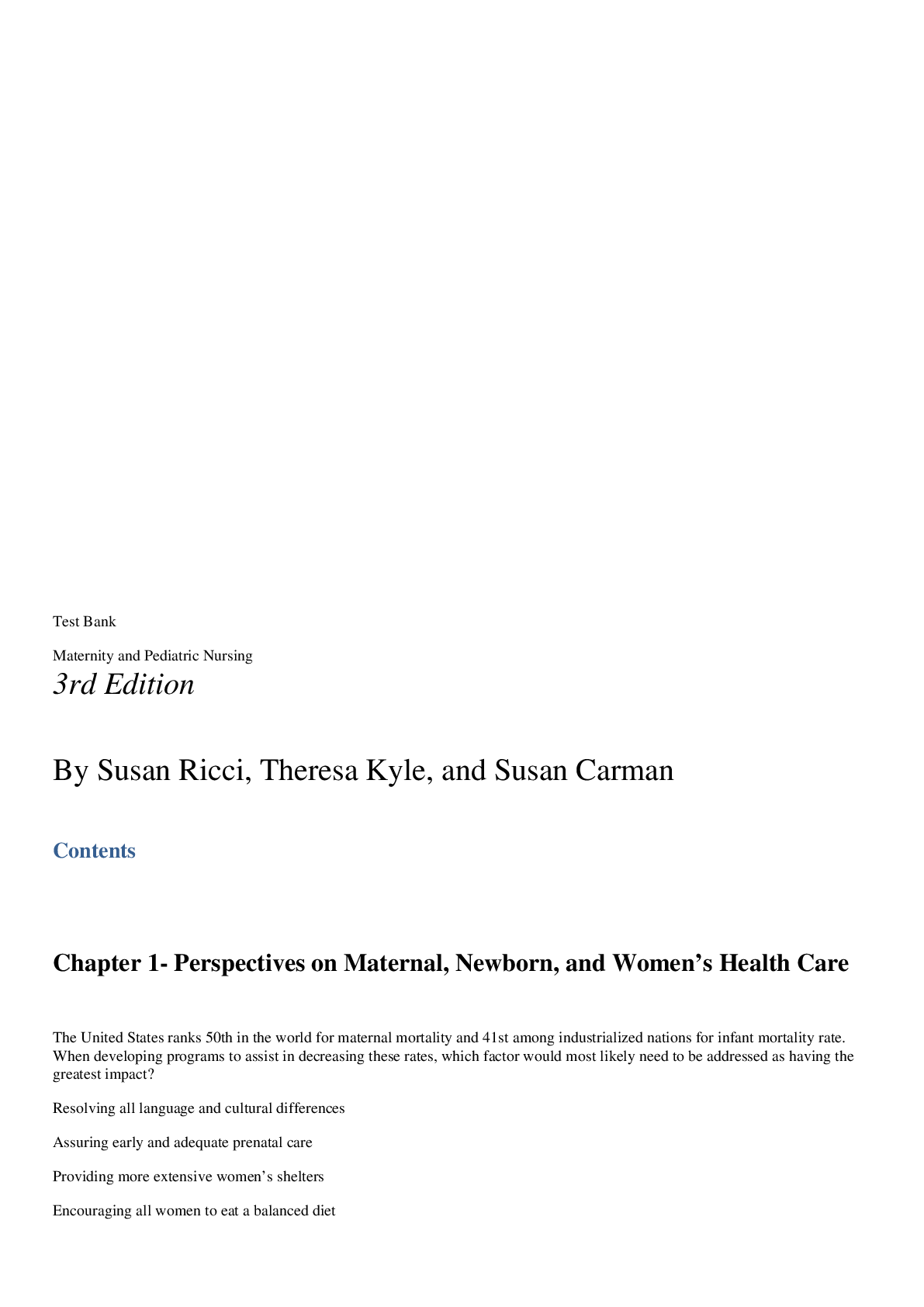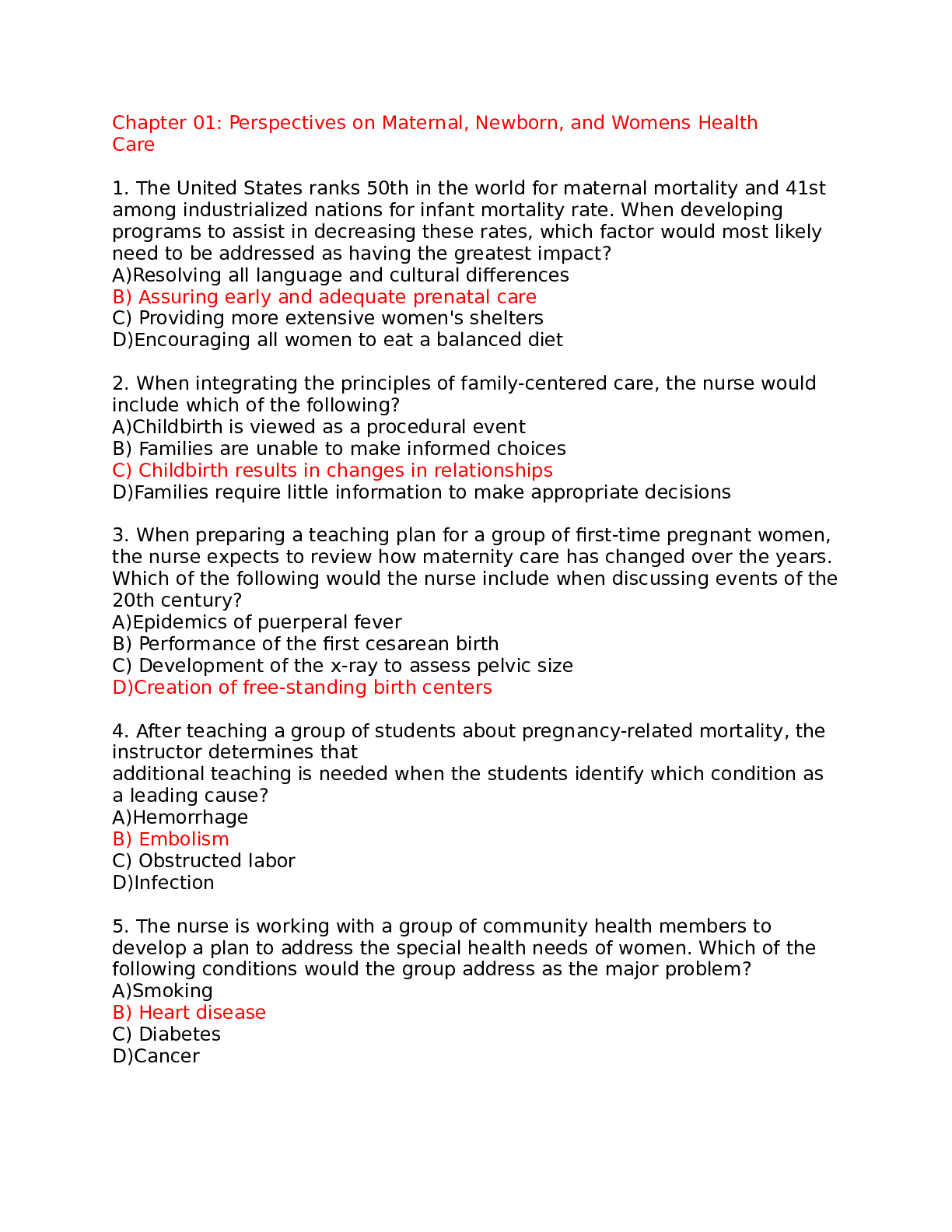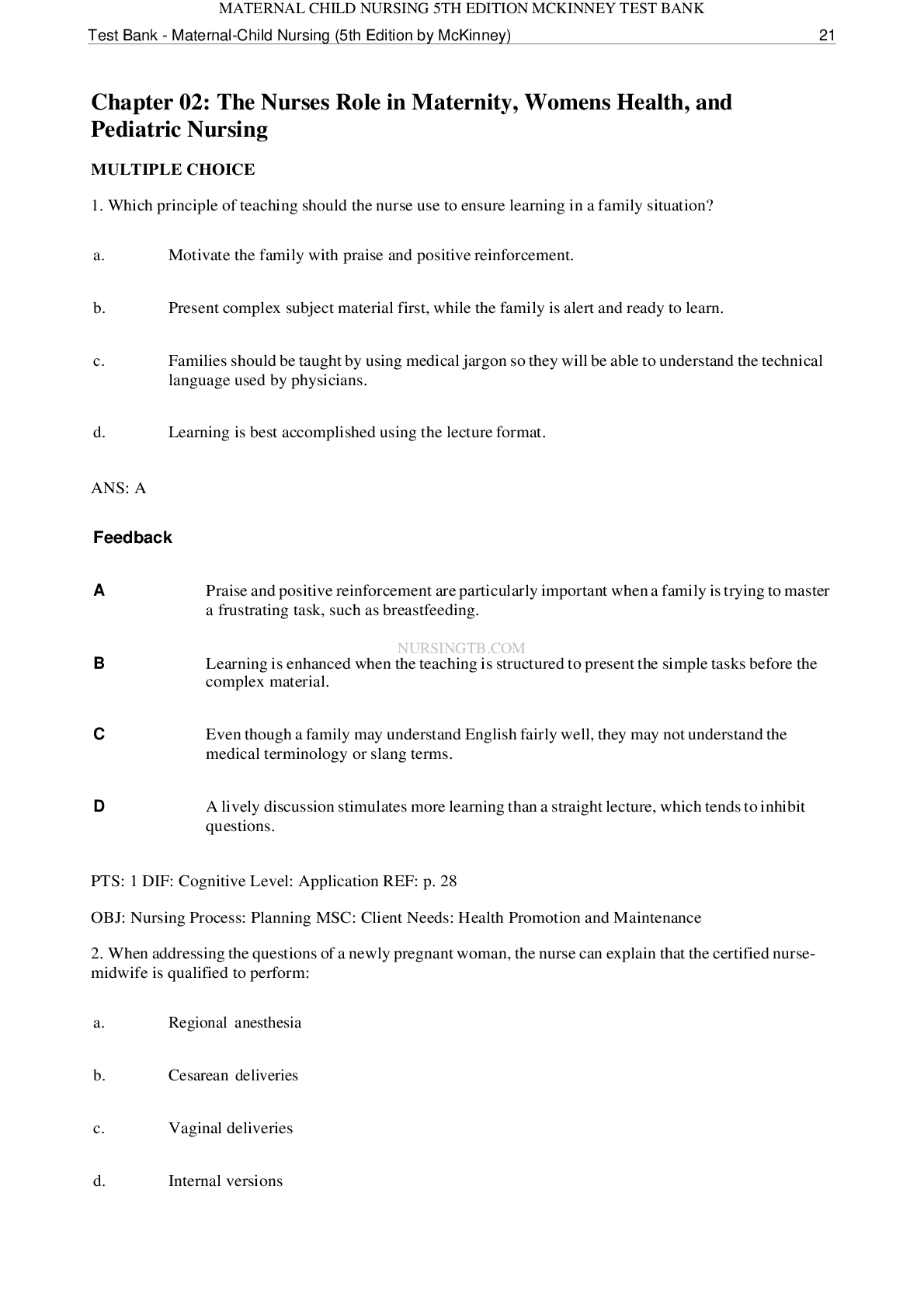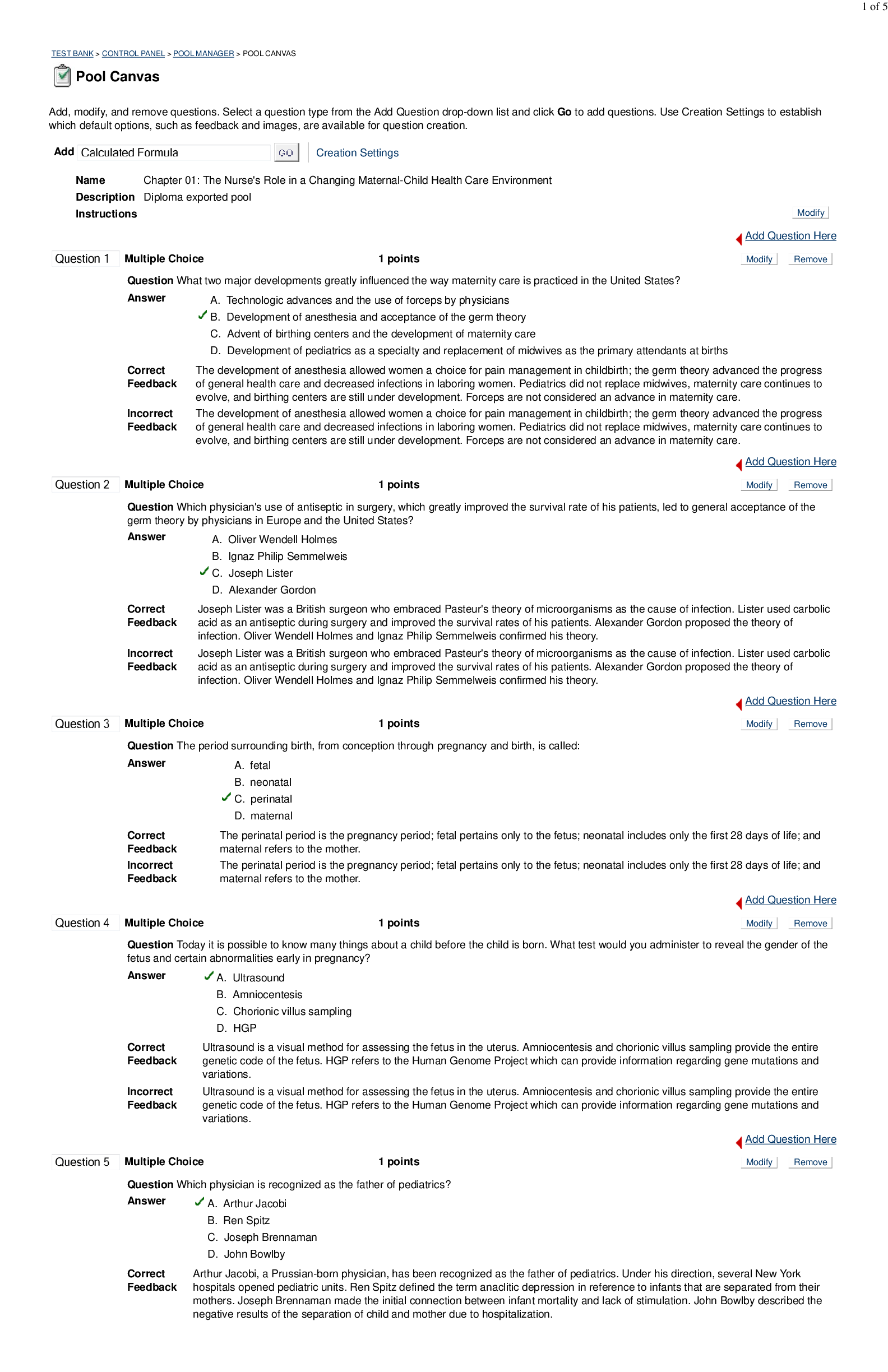*NURSING > TEST BANK > Test Bank for Introductory Maternity and Pediatric Nursing 4th Edition Hatfield Chapter 1-42| Comple (All)
Test Bank for Introductory Maternity and Pediatric Nursing 4th Edition Hatfield Chapter 1-42| Complete Guide A+
Document Content and Description Below
Test Bank for Introductory Maternity and Pediatric Nursing 4th Edition Hatfield Test Bank: Chapter 1: The Nurse's Role in a Changing Maternal–Child Health Care Environment Chapter 2: Family-Centered... and Community-Based Maternal and Pediatric Nursing Chapter 3: Structure and Function of the Reproductive System Chapter 4: Special Issues of Women's Health Care and Reproduction Chapter 5: Fetal Development Chapter 6: Maternal Adaptation during Pregnancy Chapter 7: Prenatal Care Chapter 8: The Labor Process Chapter 9: Pain Management during Labor and Birth Chapter 10: Nursing Care during Labor and Birth Chapter 11: Assisted Delivery and Cesarean Birth Chapter 12: The Postpartum Woman Chapter 13: Nursing Assessment of Newborn Transition Chapter 14: Nursing Care of the Normal Newborn Chapter 15: Newborn Nutrition Chapter 16: Pregnancy at Risk: Conditions that Complicate Pregnancy Chapter 17: Pregnancy at Risk: Pregnancy-Related Complications Chapter 18: Labor at Risk Chapter 19: Postpartum Woman at Risk Chapter 20: The Newborn at Risk: Gestational and Acquired Disorders Chapter 21: The Newborn at Risk: Congenital Disorders Chapter 22: Principles of Growth and Development Chapter 23:Growth and Development of the Infant: 28 Days to 1 Year Chapter 24:Growth and Development of the Toddler: 1 to 3 Years Chapter 25:Growth and Development of the Preschool Child: 3 to 6 Years Chapter 26:Growth and Development of the School-Aged Child: 6 to 10 Years Chapter 27:Growth and Development of the Adolescent: 11 to 18 Years UNIT VIII: FOUNDATIONS OF PEDIATRIC NURSING Chapter 28: Data Collection (Assessment) for the Child Chapter 29: Care of the Hospitalized Child Chapter 30: Procedures and Treatments Chapter 31: Medication Administration and Intravenous Therapy UNIT IX: SPECIAL CONCERNS OF PEDIATRIC NURSING Chapter 32: The Child with a Chronic Health Problem Chapter 33: Abuse in the Family and Community Chapter 34: The Dying Child UNIT X: THE CHILD WITH A HEALTH DISORDER Chapter 35: The Child with a Sensory/Neurologic Disorder Chapter 36: The Child with a Respiratory Disorder Chapter 37: The Child with a Cardiovascular/Hematologic Disorder Chapter 38: The Child with a Gastrointestinal/Endocrine Disorder Chapter 39: The Child with a Genitourinary Disorder Chapter 40: The Child with a Musculoskeletal Disorder Chapter 41: The Child with an Integumentary Disorder/Communicable Disease Chapter 42: The Child with a Psychosocial Disorder Chapter 1: The Nurse's Role in a Changing Maternal–Child Health Care Environment MULTIPLE CHOICE 1. Which principle of teaching should the nurse use to ensure learning in a family situation? a. Motivate the family with praise and positive feedback. b. Learning is best accomplished with the lecture format. c. Present complex subject material first while the family is alert and ready to learn. d. Families should be taught using medical jargon so they will be able to understand the technical language used by physicians. ANS: A Praise and positive feedback are particularly important when a family is trying to master a frustrating task such as breastfeeding. A lively discussion stimulates more learning than a straight lecture, which tends to inhibit questions. Learning is enhanced when the teaching is structured to present the simple tasks before the complex material. Even though a family may understand English fairly well, they may not understand the medical terminology or slang terms that are used. PTS: 1 DIF: Cognitive Level: Application REF: 18, 19 OBJ: Nursing Process Step: Planning MSC: Client Needs: Health Promotion and Maintenance 2. Which nursing intervention is an independent function of the nurse? a. Administering oral analgesics b. Requesting diagnostic studies c. Teaching the client perineal care d. Providing wound care to a surgical incision ANS: C Nurses are now responsible for various independent functions, including teaching, counseling, and intervening in nonmedical problems. Interventions initiated by the physician and carried out by the nurse are called dependent functions. Administrating oral analgesics is a dependent function; it is initiated by a physician and carried out by a nurse. Requesting diagnostic studies is a dependent function. Providing wound care is a dependent function; it is usually initiated by the physician through direct orders or protocol. PTS: 1 DIF: Cognitive Level: Understanding REF: 24 OBJ: Nursing Process Step: Assessment MSC: Client Needs: Safe and Effective Care Environment 3. Which most therapeutic response to the clients statement, Im afraid to have a cesarean birth should be made by the nurse? a. Everything will be OK. b. Dont worry about it. It will be over soon. c. What concerns you most about a cesarean birth? d. The physician will be in later and you can talk to him. ANS: C The response, What concerns you most about a cesarean birth focuses on what the client is saying and asks for clarification, which is the most therapeutic response. The response, Everything will be ok is belittling the clients feelings. The response, Dont worry about it. It will be over soon will indicate that the clients feelings are not important. The response, The physician will be in later and you can talk to him does not allow the client to verbalize her feelings when she wishes to do that. PTS: 1 DIF: Cognitive Level: Application REF: 18 OBJ: Nursing Process Step: Implementation MSC: Client Needs: Psychosocial Integrity 4. Which action should the nurse take to evaluate the clients learning about performing infant care? a. Demonstrate infant care procedures. b. Allow the client to verbalize the procedure. c. Routinely assess the infant for cleanliness. d. Observe the client as she performs the procedure. ANS: D The clients correct performance of the procedure under the nurses supervision is the best proof of her ability. Demonstration is an excellent teaching method, but not an evaluation method. During verbalization of the procedure, the nurse may not pick up on techniques that are incorrect. It is not the best tool for evaluation. Routinely assessing the infant for cleanliness will not ensure that the proper procedure is carried out. The nurse may miss seeing that unsafe techniques being used. PTS: 1 DIF: Cognitive Level: Application REF: 21 OBJ: Nursing Process Step: Evaluation MSC: Client Needs: Health Promotion and Maintenance 5. A nurse is reviewing teaching and learning principles. Which situation is most conducive to learning? a. An auditorium is being used as a classroom for 300 students. b. A teacher who speaks very little Spanish is teaching a class of Hispanic students. c. A class is composed of students of various ages and educational backgrounds. d. An Asian nurse provides nutritional information to a group of pregnant Asian women. ANS: D A clients culture influences the learning process; thus, a situation that is most conducive to learning is one in which the teacher has knowledge and understanding of the clients cultural beliefs. A large class is not conducive to learning. It does not allow questions, and the teacher cannot see nonverbal cues from the students to ensure understanding. The ability to understand the language in which teaching is done determines how much the client learns. Clients for whom English is not their primary language may not understand idioms, nuances, slang terms, informed usage of words, or medical terms. The teacher should be fluent in the language of the student. Developmental levels and educational levels influence how a person learns best. For the teacher to present the information in the best way, the class should be at the same level. PTS: 1 DIF: Cognitive Level: Application REF: 20 OBJ: Nursing Process Step: Planning MSC: Client Needs: Psychosocial Integrity 6. Which is the step of the nursing process in which the nurse determines the appropriate interventions for the identified nursing diagnosis? a. Planning b. Evaluation c. Assessment d. Intervention ANS: A The third step in the nursing process involves planning care for problems that were identified during assessment. The evaluation phase is determining whether the goals have been met. During the assessment phase, data are collected. The intervention phase is when the plan of care is carried out. PTS: 1 DIF: Cognitive Level: Understanding REF: 24 OBJ: Nursing Process Step: Planning MSC: Client Needs: Safe and Effective Care Environment 7. Which goal is most appropriate for the collaborative problem of wound infection? a. The client will not exhibit further signs of infection. b. Maintain the clients fluid intake at 1000 mL/8 hr. c. The client will have a temperature of 98.6 F within 2 days. d. Monitor the client to detect therapeutic response to antibiotic therapy. ANS: D In a collaborative problem, the goal should be nurse-oriented and reflect the nursing interventions of monitoring or observing. Monitoring for complications such as further signs of infection is an independent nursing role. Intake and output is an independent nursing role. Monitoring a clients temperature is an independent nursing role. PTS: 1 DIF: Cognitive Level: Application REF: 18 OBJ: Nursing Process Step: Planning MSC: Client Needs: Safe and Effective Care Environment 8. Which nursing intervention is correctly written? a. Force fluids as necessary. b. Observe interaction with the infant. c. Encourage turning, coughing, and deep breathing. d. Assist to ambulate for 10 minutes at 8 AM, 2 PM, and 6 PM. ANS: D Interventions might not be carried out if they are not detailed and specific. Force fluids is not specific; it does not state how much. Encouraging the client to turn, cough, and breathe deeply is not detailed and specific. Observing interaction with the infant does not state how often this procedure should be done. PTS: 1 DIF: Cognitive Level: Application REF: 25 OBJ: Nursing Process Step: Planning MSC: Client Needs: Safe and Effective Care Environment 9. The client makes the statement: Im afraid to take the baby home tomorrow. Which response by the nurse would be the most therapeutic? a. Youre afraid to take the baby home? b. Dont you have a mother who can come and help? c. You should read the literature I gave you before you leave. d. I was scared when I took my first baby home, but everything worked out. ANS: A This response uses reflection to show concern and open communication. The other choices are blocks to communication. Asking if the client has a mother who can come and help blocks further communication with the client. Telling the client to read the literature before leaving does not allow the client to express her feelings further. Sharing your feelings about your experience with a new baby blocks further communication with the client. PTS: 1 DIF: Cognitive Level: Application REF: 18, 19 OBJ: Nursing Process Step: Implementation MSC: Client Needs: Psychosocial Integrity 10. The nurse is writing an expected outcome for the nursing diagnosisacute pain related to trauma of tissue, secondary to vaginal birth, as evidenced by client stating pain of 8 on a scale of 10. Which is a correctly stated expected outcome for this problem? a. Client will state that pain is a 2 on a scale of 10. b. Client will have a reduction in pain after administration of the prescribed analgesic. c. Client will state an absence of pain 1 hour after administration of the prescribed analgesic. d. Client will state that pain is a 2 on a scale of 10, 1 hour after the administration of the prescribed analgesic. ANS: D The outcome should be client-centered, measurable, realistic, and attainable and have a time frame. Client stating that pain is now 2 on a scale of 10 lacks a time frame. Client having a reduction in pain after administration of the prescribed analgesic lacks a measurement. Client stating an absence of pain 1 hour after the administration of prescribed analgesic is unrealistic. PTS: 1 DIF: Cognitive Level: Application REF: 25 OBJ: Nursing Process Step: Planning MSC: Client Needs: Physiologic Integrity 11. Which nursing diagnosis should the nurse set as a priority for a laboring client? a. Risk for anxiety related to upcoming birth b. Risk for imbalanced nutrition related to NPO status c. Risk for altered family processes related to new addition to the family d. Risk for injury (maternal) related to altered sensations and positional or physical changes ANS: D The nurse should determine which problem needs immediate attention. Risk for injury is the problem that has the priority at this time because it is a safety problem. Risk for anxiety, imbalanced nutrition, and altered family processes are not the priorities at this time. PTS: 1 DIF: Cognitive Level: Application REF: 24, 25 OBJ: Nursing Process Step: Implementation MSC: Client Needs: Safe and Effective Care Environment 12. Regarding advanced roles of nursing, which statement is true with regard to clinical practice? a. Family nurse practitioners (FNPs) can assist with childbirth care in the hospital setting. b. Clinical nurse specialists provide primary care to obstetric clients. c. Neonatal nurse practitioners provide emergency care in the postbirth setting to high-risk infants. d. A certified nurse midwife (CNM) is not considered to be an advanced practice nurse. ANS: C Neonatal NPs provide care for the high-risk neonate in the birth room and in the neonatal intensive care unit, as needed. FNPs do not participate in childbirth care but can take care of uncomplicated pregnancies and postbirth care outside of the hospital setting. CNSs work in hospital settings but do not provide primary care services to clients. A CNM is an advanced practice nurse who receives additional certification in the specific area of midwifery. PTS: 1 DIF: Cognitive Level: Application REF: 17 OBJ: Nursing Process Step: Evaluation MSC: Client Needs: Management of Care: Legal Rights and Responsibilities 13. You are taking care of a couple postbirth who are very eager to learn about bathing techniques that they can use for their newborn. Which teaching technique could the nurse use to facilitate parents learning about giving a bath to their newborn infant? a. Provide direct, step-by-step demonstration to each parent separately to foster individual retention and comprehension. b. Present information to parents prior to discharge so that the information will be current. c. Have each parent bathe the newborn each time the infant comes to the room and provide commentary after the skill repetition. d. Demonstrate bathing techniques on the newborn infant with parents in attendance. ANS: D Demonstration of bathing techniques is a form of role modeling that would enhance teaching and learning outcomes. Presenting the information at the time of discharge will not allow for identification of concerns and/or evaluation of whether the skill has been acquired. Although it may be advantageous to have each parent bathe their newborn, this action would not be advised in terms of time management and safety related to maintenance of core temperature. PTS: 1 DIF: Cognitive Level: Application REF: 21 OBJ: Nursing Process Step: Implementation MSC: Client Needs: Health Promotion: Teaching/Learning 14. Which statement is true regarding the shortage of nurses in the United States? a. There are a larger proportion of younger nurses in the workforce as compared with older nurses. b. As a result of decreased RN-to-client ratios, there is a decrease in client mortality in the clinical setting. c. Increased needs for baccalaureate nurses are not being met by current enrollment. d. There are adequate classroom and clinical facilities for training RNs. ANS: C According to an Institute of Medicine (IOM) report, by the year 2020, there will only be 50% of RNs with baccalaureate degrees. The required demand is at 80%. There are a larger proportion of older nurses in the workforce based on current research by the IOM. Increased RN-to-client ratios has resulted in decreased client mortality in the clinical setting. There are limitations of classroom and clinical facilities to train new nurses adequately. PTS: 1 DIF: Cognitive Level: Application REF: 16 OBJ: Nursing Process Step: Implementation MSC: Client Needs: Health Promotion: Teaching/Learning 15. A hospital has achieved Magnet status. Which indicators would be consistent with this type of certification? a. There is stratification of communication in a directed manner between nursing staff and administration. b. There is increased job satisfaction of nurses, with a low staff turnover rate. c. Physicians are certified in their respective specialty areas. d. All nurses have baccalaureate degrees and certification in their clinical specialty area. ANS: B Magnet status is a certification offered by the ANCC (American Nurses Credentialing Center) in which hospitals apply based on designated criteria that consider nurse job satisfaction, staff patterns, strength, quality of nursing staff, and open communication. It is not based on physician status. Although the expectation is that at least 80% of the nurses will have baccalaureate degrees, most hospitals that achieve Magnet status have 50% of RNs at that level. Also, certification is not required for all nurses at this point. The expectation with Magnet status is that nurses will continue to expand their knowledge by earning additional degrees and certification. PTS: 1 DIF: Cognitive Level: Application REF: 17 OBJ: Nursing Process Step: Assessment MSC: Client Needs: Health Promotion: Teaching/Learning 16. Which of the following indicates a nurses role as a researcher? a. Reading peer-reviewed journal articles b. Working as a member of the interdisciplinary team to provide client care c. Helping client to obtain home care post-discharge from the hospital d. Delegating tasks to unlicensed personnel to allow for more teaching time with clients ANS: A A nurse in a researcher role should look to improve her or his knowledge base by reading and reviewing evidence-based practice information as found in peer-reviewed journals. Working as a member of the interdisciplinary team to provide client care indicates that the nurse is working as a collaborator. Helping the client to obtain home care post-discharge from the hospital indicates that the nurse is working as a client advocate. Delegating tasks to unlicensed personnel to allow for more teaching time with clients indicates that the nurse is working as a manager. PTS: 1 DIF: Cognitive Level: Application REF: 21 OBJ: Nursing Process Step: Assessment MSC: Client Needs: Health Promotion: Teaching/Learning 17. A 16-year-old primipara has just completed her first prenatal visit with the health care provider. The nurse is preparing to teach her about nutrition during pregnancy. What must the nurse include in the patients teaching plan? a. Provide her with pictures of dairy products. b. Ask her, Are you ready to hear this information now? c. Read directly from the pamphlet prepared for teen mothers. d. Provide a comfortable and warm setting after she has put on her street clothes. ANS: D The nurse must structure teaching for teens in a way that suits them best. For teaching to be most effective, the physical environment must be comfortable and distractions to learning must be kept at a minimum. Pictures, videos, and computer-based materials are more effective teaching tools for younger clients. Patients must have an attitude of readiness and openness for the teaching to be effective. However, if the environment is not conducive to learning, efforts for effective teaching will be minimized. PTS: 1 DIF: Cognitive Level: Application REF: 18 OBJ: Nursing Process Step: Planning MSC: Client Needs: Health Promotion and Maintenance 18. The nurse states to the newly pregnant patient, Tell me how you feel about being pregnant. Which communication technique is the nurse using with this patient? a. Clarifying b. Paraphrasing c. Reflection d. Structuring ANS: A The nurse is attempting to follow up and check the accuracy of the patients message. Paraphrasing is restating words other than those used by the patient. Reflection is verbalizing comprehension of what the patient has said. Structuring takes place when the nurse has set guidelines or set priorities. PTS: 1 DIF: Cognitive Level: Understanding REF: 19 OBJ: Nursing Process Step: Analysis MSC: Client Needs: Health Promotion and Maintenance 19. The pregnant woman tells the nurse, I think something may be wrong with my pregnancy. Which statement by the nurse demonstrates therapeutic communication? a. Most women worry; I felt the same way when I was pregnant. b. Tell me more about what concerns you about this pregnancy. c. That is a very common concern, but your pregnancy will turn out just fine. d. You should focus on taking care of yourself and not worry so much. ANS: B Questioning is a therapeutic communication technique in which additional information is elicited by using open-ended questions. The remaining options are examples of three behaviors that block communicationinappropriate self-disclosure, providing false reassurance, and giving advice. PTS: 1 DIF: Cognitive Level: Analysis REF: 18 OBJ: Nursing Process Step: Implementation MSC: Client Needs: Psychosocial Integrity MULTIPLE RESPONSE 20. The nurse is formulating a nursing care plan for a postpartum client. Which actions by the nurse indicate use of critical thinking skills when formulating the care plan? (Select all that apply). a. Using a standardized postpartum care plan b. Determining priorities for each diagnosis written c. Writing interventions from a nursing diagnosis book d. Reflecting and suspending judgment when writing the care plan e. Clustering data during the assessment process according to normal versus abnormal ANS: B, D, E Critical thinking focuses on appraisal of the way the individual thinks, and it emphasizes reflective skepticism. Determining priorities, reflecting and suspending judgment, and clustering data are actions that indicate the use of critical thinking. Using a standardized care plan and writing interventions from a nursing diagnosis book do not show that reflection about the clients individual care is being done. Chapter 2: Family-Centered and Community-Based Maternal and Pediatric Nursing MULTIPLE CHOICE 1. The nurse is teaching a homeless pregnant teenager about prenatal care. Which should the nurse emphasize inthe teaching session? a. The importance of naming the baby b. Risk factors associated with pregnancy c. Information about employment opportunities d. Eating habits that will provide adequate nutrition ANS: D Homeless teens are more likely to have poor eating habits, smoke, and have greater risks for preterm labor, anemia, and hypertension during pregnancy and to deliver a low-birth-weight (LBW) infant. Teaching about proper eating habits is the priority at this time. Naming the baby, risk factors associated with pregnancy, and information about employment are not the highest priorities to teach at this time. PTS: 1 DIF: Cognitive Level: Application REF: 35 OBJ: Nursing Process Step: Implementation MSC: Client Needs: Health Promotion and Maintenance 2. The United States ranks 27th interms of worldwide infant mortality rates. Which factor has the greatest impact on decreasing the mortality rate of infants? a. Providing more womens shelters b. Ensuring early and adequate prenatal care c. Resolving all language and cultural differences d. Enrolling pregnant women inthe Medicaid program by their eighth month of pregnancy ANS: B Because preterm infants form the largest category of those needing expensive intensive care, early pregnancy intervention is essential for decreasing infant mortality. The women inshelters have the same difficulties inobtaining health care as other poor people, particularly lack of transportation and inconvenient clinic hours. Language and cultural differences are not infant mortality issues but must be addressed to improve overall health care. Medicaid provides health care for poor pregnant women, but the process may take weeks to take effect. The eighth month is too late to apply and receive benefits for this pregnancy. PTS: 1 DIF: Cognitive Level: Understanding REF: 35 OBJ: Nursing Process Step: Assessment MSC: Client Needs: Health Promotion and Maintenance 3. Which statement is true regarding the quality assurance or incident report? a. Reports are a permanent part of the patients chart. b. The report assures the legal department that there is no problem. c. The nurses notes should contain this statement: Incident report filed and copy placed inchart. d. This report is a form of documentation of an event that may result inlegal action. ANS: D Documentation on the chart should include all factual information regarding the clients condition that would be recorded inany situation. The nurse completes an incident report when something occurs that might result ina legal action against the clinic or hospital. Incident reports are not part of the patients chart. The report is a warning to the legal department to be prepared for a potential legal action. Incident reports are not mentioned inthe nurses notes. PTS: 1 DIF: Cognitive Level: Analysis REF: 39 OBJ: Nursing Process Step: Implementation MSC: Client Needs: Safe and Effective Care Environment 4. The nurse is planning a teaching session for staff on ethical theories. Which situation best reflects the deontologic theory? a. Approving a physician-assisted suicide b. Supporting the transplantation of fetal tissue and organs c. Using experimental medications for the treatment of AIDS d. Initiating resuscitative measures on a 90-year-old patient with terminal cancer ANS: D In the deontologic theory, life must be maintained at all costs, regardless of quality of life. Approving a physician-assisted suicide, supporting the transplantation of fetal tissue and organs, and using experimental medications for the treatment of AIDS are examples of a utilitarian model. PTS: 1 DIF: Cognitive Level: Application REF: 29 OBJ: Nursing Process Step: Planning MSC: Client Needs: Psychosocial Integrity 5. Which step of the nursing process is being used when the nurse decides whether an ethical dilemma exists? a. Analysis b. Planning c. Evaluation d. Assessment ANS: A When a nurse uses the collected data to determine whether an ethical dilemma exists, the data are being analyzed. Planning is done after the data have been analyzed. Evaluation occurs once the outcome has been achieved. Assessment is the data collection phase. PTS: 1 DIF: Cognitive Level: Understanding REF: 30 OBJ: Nursing Process Step: Evaluation MSC: Client Needs: Safe and Effective Care Environment: Coordinated Care 6. The nurse is interviewing a 6-week pregnant client. The client asks the nurse, Why is elective abortion considered an ethical issue? Which is the best response that the nurse should make? a. Abortion requires third-party consent. b. The U.S. Supreme Court ruled that life begins at conception. c. Abortion law is unclear about a womans constitutional rights. d. There is a conflict between the rights of the woman and the rights of the fetus. ANS: D Elective abortion is an ethical dilemma because two opposing courses of action are available. Abortion does not require third-party consent. The Supreme Court has not ruled on when life begins. Abortion laws are clear concerning a womens constitutional rights. PTS: 1 DIF: Cognitive Level: Application REF: 31 OBJ: Nursing Process Step: Implementation MSC: Client Needs: Safe and Effective Care Environment 7. At the present time, surrogate parenting is governed by which of the following? a. State law b. Federal law c. Individual court decision d. Protective child services ANS: C Each surrogacy case is decided individually ina court of law. Surrogacy is not governed by state law. Surrogacy is not governed by federal law. Protective child services does not make decisions about surrogacy. PTS: 1 DIF: Cognitive Level: Understanding REF: 33 OBJ: Nursing Process Step: Assessment MSC: Client Needs: Health Promotion and Maintenance 8. Which client will most likely seek prenatal care? a. Janice, 15 years old, tells her friends, I dont believe I am pregnant. b. Carol, 28 years old, is inher second pregnancy and abuses drugs and alcohol. c. Margaret, 20 years old, is inher first pregnancy and has access to a free prenatal clinic. d. Glenda, 30 years old, is inher fifth pregnancy and delivered her last infant at home with the help of her mother and sister. ANS: C The client who acknowledges the pregnancy early, has access to health care, and has no reason to avoid health care is most likely to seek prenatal care. Being indenial about the pregnancy will prevent a client from seeking health care. Substance abusers are less likely to seek health care. Some women see pregnancy and birth as a natural occurrence and do not seek health care. PTS: 1 DIF: Cognitive Level: Understanding REF: 35 OBJ: Nursing Process Step: Assessment MSC: Client Needs: Health Promotion and Maintenance 9. A medical surgical nurse is asked to float to a womens health unit to care for clients who are scheduled for therapeutic abortions. The nurse refuses to accept this assignment and expresses her personal beliefs as being incongruent with this medical practice. The nursing supervisor states that the unit is short-staffed and that they could really use her expertise because it just involves taking care of clients who have undergone a surgical procedure. inconsideration of legal and ethical practices, can the nursing supervisor enforce this assignment? a. The staff nurse has the responsibility of accepting any assignment that is made while working for a health care unit, so the nursing supervisor is within his or her rights to enforce this assignment. b. Because the unit is short-staffed, the staff nurse should accept the assignment to provide care by benefit of her or his experience to clients who need care. c. The staff nurse has expressed a legitimate concern based on his or her feelings; the nursing supervisor does not have the authority to enforce this assignment. d. The nursing supervisor should emphasize that this assignment requires care of a surgical client for which the staff nurse is adequately trained and should therefore enforce the assignment. ANS: C The Nurse Practice Act allows nurses to refuse assignments that involve practices that they have expressed as being opposed to their religious, cultural, ethical, and/or moral values. Although the nursing supervisor has a right to arrange assignments, the supervisor, if made aware of a potential bias or limitation, must act accordingly and accept the nurses position. This should be upheld regardless of staffing limitations and independent of persuasive efforts to make the nurse feel guilty for her or his stated beliefs. PTS: 1 DIF: Cognitive Level: Analysis REF: 31 OBJ: Nursing Process Step: Implementation MSC: Client Needs: Safe Effective Care: Ethical Practice/Assignment, Delegation and Supervision 10. With regard to an obstetric litigation case, a nurse working inlabor and birth is found to be negligent. Which intervention performed by the nurse indicates that a breach of duty has occurred? a. The nurse did not document fetal heart tones (FHR) during the second stage of labor. b. The client was only provided ice chips during the labor period, which lasted 8 hours. c. The nurse allowed the client to use the bathroom rather than a bedpan during the first stage of labor. d. The nurse asked family members to leave the room when she prepared to do a pelvic exam on the client. ANS: A A breach of duty is indicated by a nurse (or health care provider) failing to provide treatment relative to the standard of care. inthis case, documentation of FHR during the second stage of labor is a standard of care. Providing ice chips to laboring clients is within the standard of care. The time period of 8 hours is not excessive. A client without any risk factors can use the bathroom and be ambulatory during the first stage of labor. Asking family members to leave during a vaginal exam helps maintain client privacy. PTS: 1 DIF: Cognitive Level: Analysis REF: 37 OBJ: Nursing Process Step: Implementation MSC: Client Needs: Safe Effective Care: Legal Rights and Responsibilities 11. A nurse is working with a labor client who is inpreterm labor and is designated as a high-risk client. The client is very apprehensive and asks the nurse, Is everything going to be all right? The nurse tells the client, Everything will be okay. Following birth via an emergency cesarean section, the newborn undergoes resuscitation and does not survive. The client is distraught over the outcome and blames the nurse for telling her that everything would be okay. Which ethical principle did the nurse violate? a. Autonomy b. Fidelity c. Beneficence d. Accountability ANS: B In this type of situation, the nurse (and/or health care provider) cannot make statements (promises) that cannot be kept. Telling the client that everything will be okay is not based on the accuracy of medical diagnosis and should not be conveyed to the client. The other ethical principles of autonomy (self-determination), beneficence (greatest good), and accountability (accepting responsibility) do not apply. PTS: 1 DIF: Cognitive Level: Analysis REF: 30 OBJ: Nursing Process Step: Implementation MSC: Client Needs: Safe Effective Care: Legal Rights and Responsibilities 12. A nurse is working inthe area of labor and birth. Her assignment is to take care of a gravida 1 para 0 who presents inearly labor at term. Vaginal exam reflects the following: 2 cm, cervix posterior, 1 station, and vertex with membranes intact. The client asks the nurse if she can break her water so that her labor can go faster? The nurses response, based on the ethical principle of nonmaleficence, is which of the following? a. Tell the client that she will have to wait until she has progressed further on the vaginal exam and then she will perform an amniotomy. b. Have the client write down her request and then call the physician for an order to implement the amniotomy. c. Instruct the client that only a physician or certified midwife can perform this procedure. d. Give the client an enema to stimulate labor. ANS: C The ethical principle of nonmaleficence conveys the concept that one should avoid risk taking or harm to others. The procedure of amniotomy is performed by a physician and/or certified nurse midwife. It is not inthe scope of practice of a RN, so option C validates that the nurse is upholding this ethical principle. Options A and B are not within the scope of practice. The use of an enema as a labor stimulant is no longer considered to be part of labor and birth practices. PTS: 1 DIF: Cognitive Level: Analysis REF: 30 OBJ: Nursing Process Step: Implementation MSC: Client Needs: Safe Effective Care: Legal Rights and Responsibilities 13. A nurse working ina labor and birth unit is asked to take care of two high-risk clients inthe labor and birth suite: a 34 weeks gestation 28-year-old gravida 3, para 2 inpreterm labor and a 40-year-old gravida 1, para 0 who is severely preeclamptic. The nurse refuses this assignment telling the charge nurse that based on individual client acuity, each client should have one-on- one care. Which ethical principle is the nurse advocating? a. Accountability b. Beneficence c. Justice d. Fidelity ANS: B In this situation, the clients are each exhibiting significant high-risk conditions and should receive individual nursing care. The nurse is advocating the principle of beneficence inthat she is trying to do the greatest good or the least harm to improve client outcomes. The other ethical principles do not apply inthis situation. PTS: 1 DIF: Cognitive Level: Analysis REF: 30 OBJ: Nursing Process Step: Implementation MSC: Client Needs: Safe Effective Care: Legal Rights and Responsibilities 14. A charge nurse is working on a postpartum unit and discovers that one of the clients did not receive AM care during her shift assessment. The charge nurse questions the nurse assigned to provide care and finds out that the nurse thought that the client should just do it by herself because she will have to do this at home. On further questioning of the nurse, it is determined that the rest of her assigned clients were provided AM care. The assigned nurse has violated which ethical principle? a. Justice b. Truth c. Confidentiality d. Autonomy ANS: A The ethical principle of justice indicates that all clients should be treated equally and fairly. inthis case, the charge nurse ascertained that the AM care was not equally applied to all the nurses assigned clients. The other ethical principles do not apply to this situation. PTS: 1 DIF: Cognitive Level: Analysis REF: 30 OBJ: Nursing Process Step: Implementation MSC: Client Needs: Safe Effective Care: Legal Rights and Responsibilities 15. A nurse is entering information on the clients electronic health record (EHR) and is called to assist inan emergency situation with regard to another client inthe labor and birth suite. The nurse rushes to the scene to assist but leaves the chart open on the computer screen. The emergent client situation is resolved satisfactorily, and the nurse comes back to the computer entry screen to complete charting. At the end of the shift, the nurse manager asks to speak with the nurse and tells her that she is concerned with what happened today on the unit because there was a breach inconfidentiality. Which response by the nurse indicates that she understands the nurse managers concerns? a. The nurse acknowledges that she should have made sure that her client was safe before assisting with the emergency. b. The nurse states that she should have logged out of the EHR prior to attending to the emergency. c. The nurse indicates that the unit was understaffed. d. The nurse indicates that the she changed her password following the clinical emergency to maintain confidentiality. ANS: B With the use of electronic health records, it is necessary to take all steps to maintain confidentiality and limit access to nonhealth care personnel. inan emergent care situation, the nurse should have logged out of the system to maintain confidentiality. Although it is important to make sure that ones client is safe, there is no information here to suggest that there were any safety issues applicable to her assigned client. The staffing of the unit should not affect confidentiality. Changing the password for logging into a system is an option for clinical practice but does not affect the situation as described. PTS: 1 DIF: Cognitive Level: Analysis REF: 30 OBJ: Nursing Process Step: Implementation MSC: Client Needs: Safe Effective Care: Legal Rights and Responsibilities 16. Which of the following statements is true regarding late preterm infants? a. These infants are born before 32 weeks gestation and thus are at higher risk than LBW infants. b. These infants do better than LBW infants because their weight provides added protection against physiologic stressors. c. Care of these infants has led to increased health care costs compared with LBW infants. d. These infants suffer fewer respiratory problems than LBW infants. ANS: C Late preterm infants are born between 34 and 36 weeks and present with more complications than LBW infants, according to evidence-based practice. The added weight does not provide protection, and these infants are more likely to experience respiratory distress. PTS: 1 DIF: Cognitive Level: Application REF: 36 OBJ: Nursing Process Step: Assessment MSC: Client Needs: Physiologic Adaptation 17. A nurse is admitting a client to the labor and birth unit inearly labor who was sent to the facility following her checkup with her health care provider inthe office. The client is a gravida 1, para 0, and is at term. No health issues are discerned from the initial assessment, and the nurse prepares to initiate physician orders based on standard procedures. Which action is warranted by the nurse manager inresponse to this situation? a. No action is indicated because the nurse is acting within the scope of practice. b. The nurse manager should intervene and ask the nurse to clarify admission orders directly with the physician. c. The nurse manager should review standard procedures with the nurse to validate that orders are being carried out accurately. d. The nurse manger should review the admission procedure with the nurse. ANS: A Standard procedures are often used inlabor and birth settings because they are based on physician-directed orders that apply to general admissions. The nurse is acting appropriately because the client was sent directly to the unit by the health care provider. The nurse manager does not have to intervene at this point. There is no additional need to review standard procedures or the admission process with the nurse at this time. There is no evidence that the nurse needs additional training and/or does not have the prerequisite knowledge to admit the client. PTS: 1 DIF: Cognitive Level: Application REF: 36, 37 OBJ: Nursing Process Step: Implementation MSC: Client Needs: Health Promotion Maintenance 18. A nurse who works inthe emergency department (ED) is assigned to a client who is experiencing heavy vaginal bleeding at 12 weeks gestation. An ultrasound has confirmed the absence of a fetal heart rate, and the client is scheduled for a dilation and evacuation of the pregnancy. The nurse refuses to provide any further care for this client based on moral principles. What is the nurse managers initial response to the nurse? a. I recall you sharing that information inyour interview. I will arrange for another nurse to take report on this client. b. Because we are shorthanded today, you have to continue to provide care. There is no one else available to provide care for this client. c. I understand your point of view. You were hired to work here inthe ED so you had to know this situation was possible. d. Abandonment is a serious issue. I have to advise you to continue to provide care for this client. ANS: A Nurses do not have to provide care if the care is... [Show More]
Last updated: 1 year ago
Preview 1 out of 664 pages
Instant download
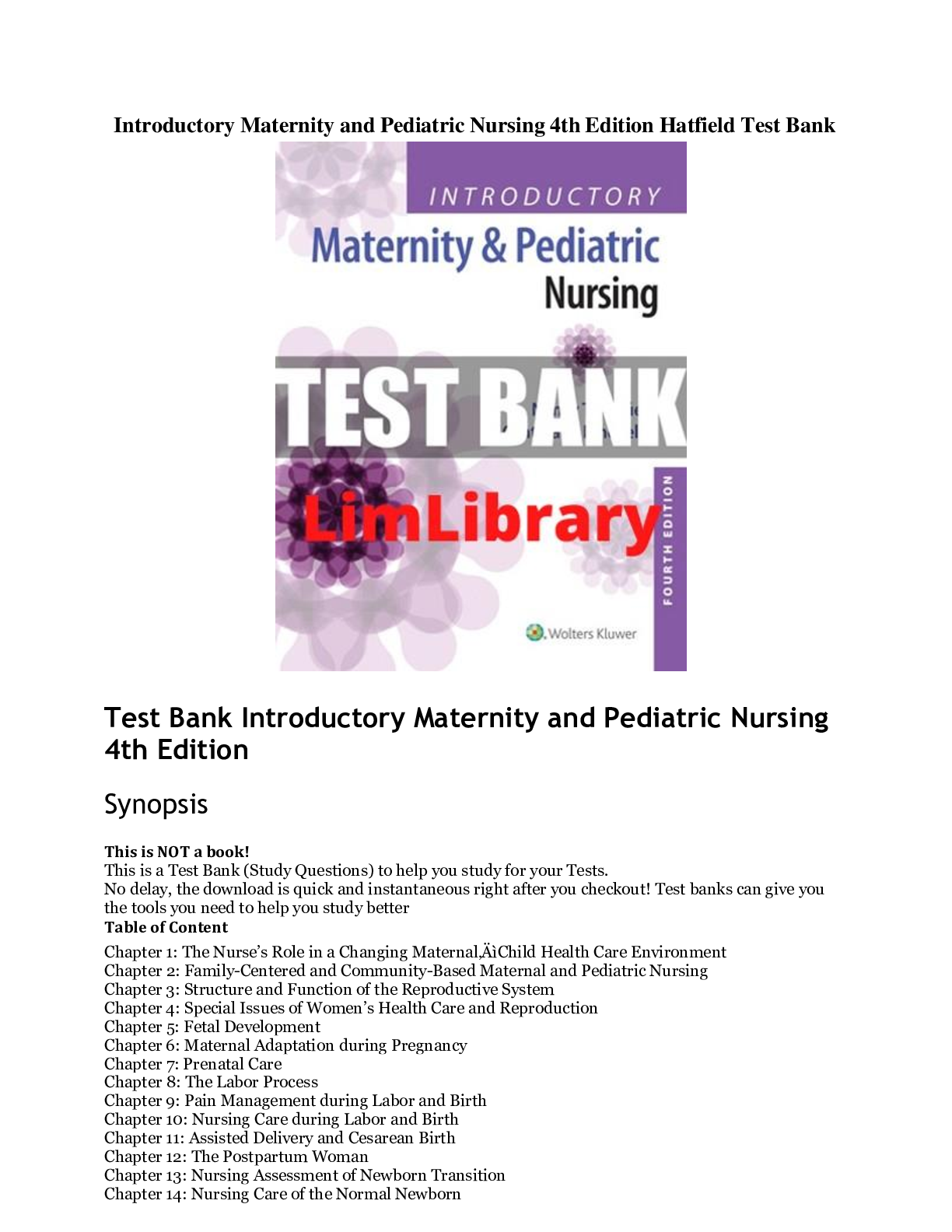
Buy this document to get the full access instantly
Instant Download Access after purchase
Add to cartInstant download
Reviews( 0 )
Document information
Connected school, study & course
About the document
Uploaded On
Aug 23, 2022
Number of pages
664
Written in
Additional information
This document has been written for:
Uploaded
Aug 23, 2022
Downloads
0
Views
33


.png)

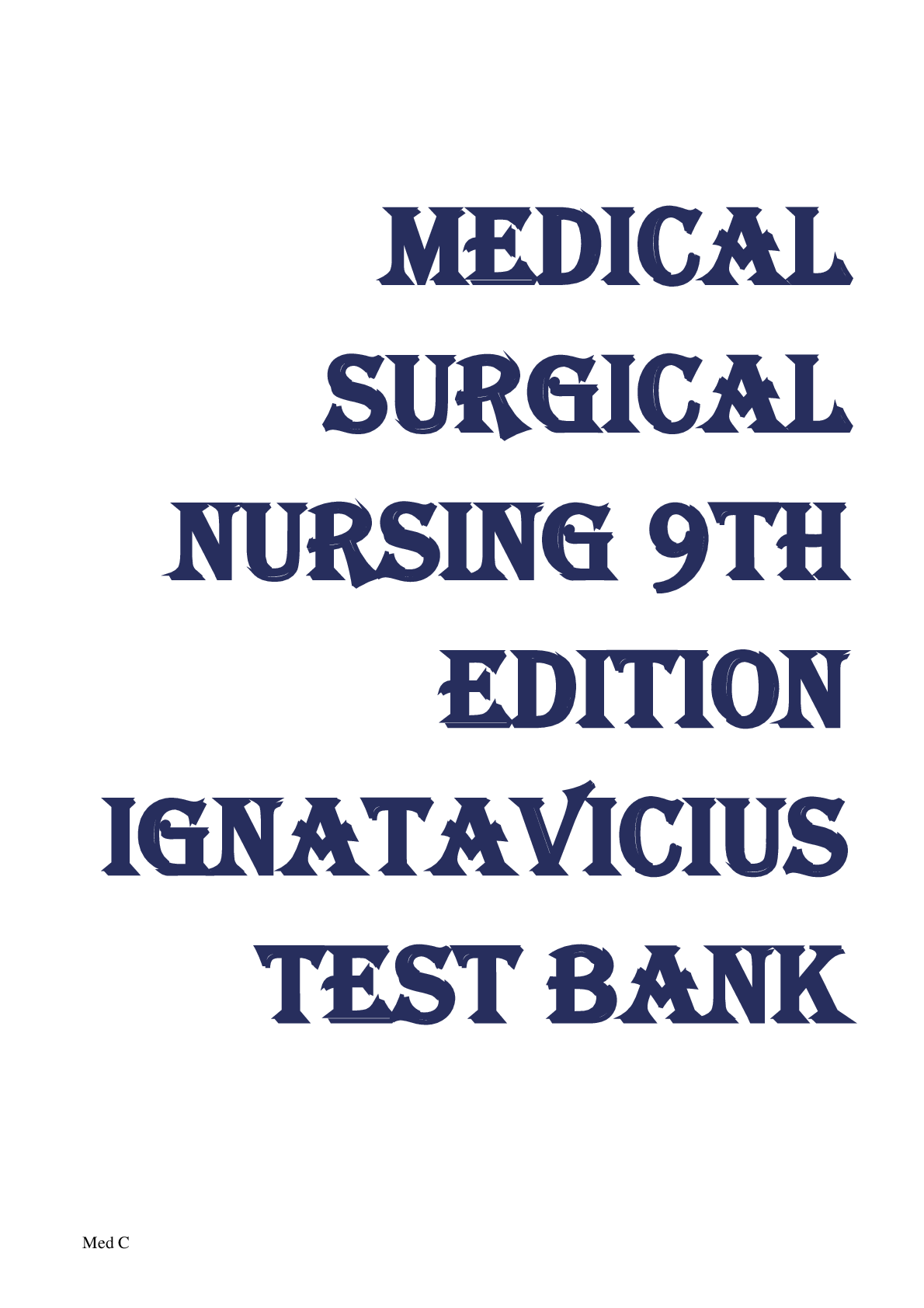

.png)
.png)
